E-Travel Log # 4: Swakopmund, Between the Desert and the Ocean
Dear Students:
Last week, Lilia and I visited two schools in a Namib Desert town on the Atlantic Ocean Coast called Swakopmund. In this report, we’ll recap our visit to Swakop (as it is called, for short), tell you a bit about the history of Swakop and Namibia, and challenge you with a couple more guess-who animal poems.
BETWEEN THE DESERT AND THE DEEP BLUE SEA
Swakopmund, with its
population of 30,000, is one of only three large towns on the Atlantic Coast
of Namibia  (Walvis
Bay and Luderitz are the others). That’s over 1200 miles of prime coast
and only three main towns. (Compare that to any stretch of the US Atlantic
Coast!) Why so few? Well, that’s simple: The Namibian Atlantic Coast
is all desert – the Namib (as you learned in the last report). So, Swakop
is sandwiched between the ocean and a desert sea: crashing waves of saltwater
to the west and creeping waves of sand to the east.
(Walvis
Bay and Luderitz are the others). That’s over 1200 miles of prime coast
and only three main towns. (Compare that to any stretch of the US Atlantic
Coast!) Why so few? Well, that’s simple: The Namibian Atlantic Coast
is all desert – the Namib (as you learned in the last report). So, Swakop
is sandwiched between the ocean and a desert sea: crashing waves of saltwater
to the west and creeping waves of sand to the east.
Swakopmund was founded in the early 1900’s by German settlers and remained a small German enclave until uranium was discovered in the 60’s, after which the town boomed, attracting Namibians from all over the country. Now, uranium mining, tourism and fishing are the town’s main industries, though lots of other business and services support the population. Swakop has many schools, parks, malls, clinics and restaurants (even Chinese and Italian restaurants!). Of course, it has beaches, too – with all kinds of shore birds, white pelicans, flamingos, seals, and even occasional jackass penguins (sorry teachers, but that is what they are called 8-).
Penguins in the Desert
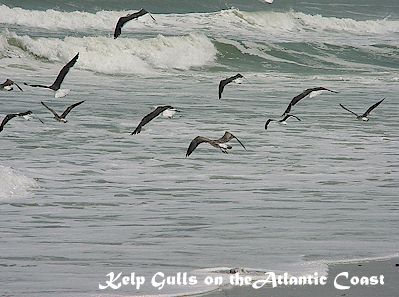 You
heard it right. Although Swakop is a desert town, its ocean waters are quite
chilly: chilly enough for penguins! That’s because the waters come from
the south – Antarctica that is – carried by the Benguala current.
The cold water generates cold winds that wash from the west over the coast,
clashing with the hot dry desert air from the east. As the desert air cools,
it condenses and forms fog. Almost every morning in the summer, a dense blanket
of fog rolls over Swakopmund and into the Namib, sometimes reaching as far
as 40 miles inland before it dissipates.
You
heard it right. Although Swakop is a desert town, its ocean waters are quite
chilly: chilly enough for penguins! That’s because the waters come from
the south – Antarctica that is – carried by the Benguala current.
The cold water generates cold winds that wash from the west over the coast,
clashing with the hot dry desert air from the east. As the desert air cools,
it condenses and forms fog. Almost every morning in the summer, a dense blanket
of fog rolls over Swakopmund and into the Namib, sometimes reaching as far
as 40 miles inland before it dissipates.
During the winter months (summer months in the northern hemisphere), though, the winds can shift, ushering torridly hot desert air over the coast. Then, for a couple of months, Swakop heats up – but not as much as in other coastal stretches of the Namib where the mercury can, for short periods, occasionally top 110 degrees F! For the rest of the year – and especially in the summer when you might expect it to be even hotter –Swakop stays cool – and nighttime temperatures can even dip into the upper forties.
A Beach Full of Birds
 We
know first hand about Swakop’s cold weather: we left all of our warm
clothes in Windhoek, thinking we wouldn’t need them in the desert –
and we were cold all week long. We stayed at a campsite on the beach and shivered
through every morning fog!
We
know first hand about Swakop’s cold weather: we left all of our warm
clothes in Windhoek, thinking we wouldn’t need them in the desert –
and we were cold all week long. We stayed at a campsite on the beach and shivered
through every morning fog!
One morning after the fog had rolled inland and the breeze warmed up, Lilia and I went for a stroll and a picnic along the beach. The water was too cold and the waves too big for swimming, but we enjoyed watching the many kinds of birds that gathered where the sea meets the sand to harvest the bonanza of washed up goodies – most prominently clams and seaweed which were strewn all over the shore. Like on any coast, the gulls dominated, though here the most common variety is called a kelp gull (see photo). We also saw lots of terns, plovers and sandpipers combing the beach for small fair; and cormorants, floating close to shore, diving under the waves and coming up with beak-sized fish. On other stretches of the beach or at other times of day, you can also see lots of flamingos and white pelicans (see photos).
We thought it amazing that Arctic terns, which I had seen a few years back in the Canadian Arctic – and which can sometimes be seen along the Atlantic Ocean Coast of the US when migrating – fly all the way from the northernmost part of the world to the southernmost part and back each year, crossing the Atlantic twice in the process. (Can you figure out how far they travel if they leave from Baffin Island in the Canadian Arctic, fly down the northern east coast of North America, cross the Atlantic to Europe, fly down the west coast of Africa to Namibia and then fly back?) You could say they really go out of their way to avoid winter, since they hop hemispheres to miss it. Or maybe they’re afraid of the dark – since Arctic and Antarctic summers include some days with twenty-four hours of sunlight. When I was visiting schools in the Arctic, I was inspired to write a haiku poem about the Arctic tern. It goes like this:
Color
of the clouds
Angular marathoner
Always in the sun
(That’s a five-seven-five haiku – with the numbers representing syllables. Maybe you can choose an African bird and try writing your own.)
The birds weren’t the only things at the beach looking for a meal. We also saw several fishermen with giant fishing rods, walking, riding their bikes or driving vehicles to their favorite fishing spots. Check out the photo of the fishing bug with the fishing rods attached to the front end.
Though we weren’t lucky enough to see a live seal (as we did last year), we did see a giant dead seal wash up onto the beach, another meal for the sea gulls.
Waves, Sand and Footprints
 By
mid-afternoon, high tide came in and forced us out of our picnic spot. We
played in the waves and discovered how the waves played with the sand. They
washed rough tan sand from the sea over the finer rust and black sand on the
beach, creating neat streaking patterns of mixed colored sand, new designs
with every wave. We discovered that we could add to the artistic effect simply
by walking across the beach before a wave arrived. The wave would fill in
our footsteps with the tan sand, and then distort the imprints by washing
over them. We’ve included a photo of the result. (How can you make art
by interacting with the natural environment around you?)
By
mid-afternoon, high tide came in and forced us out of our picnic spot. We
played in the waves and discovered how the waves played with the sand. They
washed rough tan sand from the sea over the finer rust and black sand on the
beach, creating neat streaking patterns of mixed colored sand, new designs
with every wave. We discovered that we could add to the artistic effect simply
by walking across the beach before a wave arrived. The wave would fill in
our footsteps with the tan sand, and then distort the imprints by washing
over them. We’ve included a photo of the result. (How can you make art
by interacting with the natural environment around you?)
Sand Ghost Revisited
Speaking of playing in the sand, in Travel Log #3 about the Namib Desert, we asked if you could explain the sand ghosts Lilia discovered in the sand dunes of Sossusvlei. Here’s the excerpt and the explanation:
While we were climbing one of the dunes, Lilia discovered a strange but interesting phenomenon: sand ghosts. Sitting on the ridge of a dune with her back to the rising sun, she scooped up some sand with both hands and tossed it out in front of her. As the veil of sand drifted in the air down the side of the dune, a shadowy figure, resembling Lilia herself, seemed to float away with the sand.
What appeared to be
a ghost was actually Lilia’s shadow on the veil of sand, formed because
her body 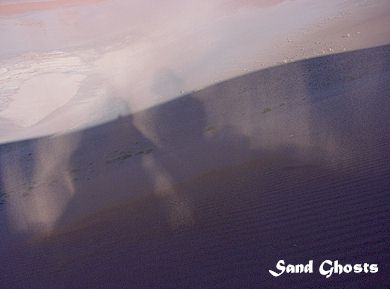 blocked
the sun rays coming from behind her. As the sand floated away, the shadow
on the sand also floated away and as the sand fell to the ground, the shadow
disappeared, like a ghost. In the photo, if you look carefully, you can actually
see two sets of shadows. The first, in the foreground, is the shadow of Lilia
and I on the sand Lilia threw in the air (again, if you look carefully, you
can even tell from the shadow that I’m taking the picture), and the
second is the shadow on the ground down at the bottom of the dune, which is
much smaller than and inside the first shadow. So, have another look at the
photo in the last report. Can you see both shadows?
blocked
the sun rays coming from behind her. As the sand floated away, the shadow
on the sand also floated away and as the sand fell to the ground, the shadow
disappeared, like a ghost. In the photo, if you look carefully, you can actually
see two sets of shadows. The first, in the foreground, is the shadow of Lilia
and I on the sand Lilia threw in the air (again, if you look carefully, you
can even tell from the shadow that I’m taking the picture), and the
second is the shadow on the ground down at the bottom of the dune, which is
much smaller than and inside the first shadow. So, have another look at the
photo in the last report. Can you see both shadows?
CHANGING HANDS THROUGH HISTORY
Swakopmund has an interesting history that reflects the recent history of Namibia in general. During the European scramble for Africa, when European countries colonized almost the whole continent at the end of the 19th and the beginning of the 20th centuries, Germany laid claim to Namibia, then known as Southwestern Africa. When Germany lost World War I, England, and later South Africa, gained control of Namibia. South Africa was controlled by a government of only white people, although by far most of the people who lived there were black. The white government established a system of apartheid which separated black and white people and denied many rights to black people, in some ways similar to how things were in parts of the United States before the 1960's. Since South Africa also controlled Namibia, they also enforced apartheid in Namibia. They separated all people into three groups: black people, white people and people who are mixed black and white (called colored people). They even divided the black people further into their ethnic groups, so one group could not live with another.
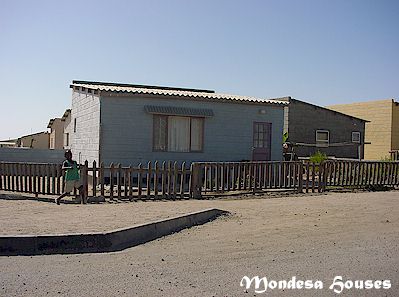 Only
fourteen years ago, Namibia got its independence from South Africa. (So, how
much older or younger than you is Namibia?) Namibia had to fight for its freedom
and the people elected one of the men who led them in the fighting, Sam Nujoma,
to be the president. (If you have studied the history of the United States,
you probably know that the first president of the United States was also a
man who led his country in their fight for freedom.) Mr. Nujoma is still the
president today, though he claims he will step down later this year at the
end of his third term.
Only
fourteen years ago, Namibia got its independence from South Africa. (So, how
much older or younger than you is Namibia?) Namibia had to fight for its freedom
and the people elected one of the men who led them in the fighting, Sam Nujoma,
to be the president. (If you have studied the history of the United States,
you probably know that the first president of the United States was also a
man who led his country in their fight for freedom.) Mr. Nujoma is still the
president today, though he claims he will step down later this year at the
end of his third term.
Since independence, Namibia has been trying to reverse the separation and the discrimination created by apartheid, but some separation and inequality still remain.
Tamariskia, Mondesa, Vineta and Little Germany
Under the system of
apartheid, Swakopmund was divided into three sections, Mondesa for black people,
 Tamariskia for colored people and Vineta for white people. Another section
of Swakop, called Little Germany, remained mainly German (and German is still
spoken there today). Nowadays, the divisions, while clear, are less pronounced.
The Tamariskia Primary School, for example, where we worked with sixth and
seventh grade students, has a mixed population, mostly of black and colored
children, with a few white children. The Hanganeni Primary School, where we
worked with 3rd through 6th grade students, has mostly black students and
a small minority of colored students. (Hanganeni, in the Ovambo language,
by the way, means ‘Let’s stand together.’) Other schools
in town have mostly white populations with small minorities of colored and
black students.
Tamariskia for colored people and Vineta for white people. Another section
of Swakop, called Little Germany, remained mainly German (and German is still
spoken there today). Nowadays, the divisions, while clear, are less pronounced.
The Tamariskia Primary School, for example, where we worked with sixth and
seventh grade students, has a mixed population, mostly of black and colored
children, with a few white children. The Hanganeni Primary School, where we
worked with 3rd through 6th grade students, has mostly black students and
a small minority of colored students. (Hanganeni, in the Ovambo language,
by the way, means ‘Let’s stand together.’) Other schools
in town have mostly white populations with small minorities of colored and
black students.
Swakopmund’s neighborhoods are also distinguishable by their houses. Vineta has large brick houses, Tamariskia has medium-sized brick house and Mondesa has small brick houses. In all three neighborhoods, the houses are mainly made of brick blocks (made of cement using desert sand) and are painted with bright colors – and all three neighborhoods have running water and electricity. But, nowadays, there are two new sections of town that emphasize the fact the Namibia still has haves and have nots. Along the ocean, north of the town, are clusters of giant luxury beach homes – and in the desert, north of the town, there is the D.R.C. The D.R.C consists of several hundred very small houses that are made of pieced-together materials like tin, wood, cardboard and cement blocks. While the houses have no electricity or running water, the neighborhood has electrical street lights and public water faucets. Most people who live in the D.R.C. are families who have recently moved to Swakopmund to look for work but haven’t found it yet. Many of the students at the Hanganeni Primary School are from the D.R.C. We found that, though they came from the poorest part of town, they were mostly very good students, attentive, respectful and eager to learn.
House of Safety: House of Smiles
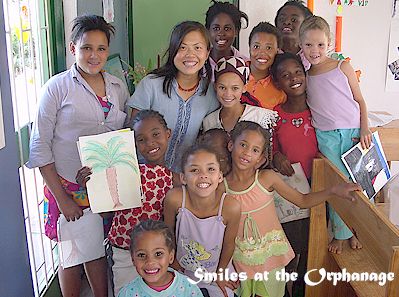 In
addition to our visits to the Tamariskia and Hanganeni schools, we visited
and worked with 16 children from age 4 to 14 at Swakopmund’s House of
Safety for Abused, Orphaned and Abandoned Children. Some of the children there
had very sad stories. For example, a few had lost their parents to AIDS and
had no other relatives who wanted to take them in. Others had been left in
the street by their mothers who, because of drug addiction, HIV/AIDS and other
issues, no longer cared or could care. One little girl had recently survived
a house fire that killed her mother and left her without a family or a home.
The House of Safety truly was a place where these children could find refuge
from their stormy pasts and begin to enjoy their childhood and find some happiness
in life. They had beautiful smiles and shared them freely with us as we gave
them artwork from US and Ecuadorian students and worked with them to create
their own artwork. (See the photo of Lilia with some girls from the home.)
In
addition to our visits to the Tamariskia and Hanganeni schools, we visited
and worked with 16 children from age 4 to 14 at Swakopmund’s House of
Safety for Abused, Orphaned and Abandoned Children. Some of the children there
had very sad stories. For example, a few had lost their parents to AIDS and
had no other relatives who wanted to take them in. Others had been left in
the street by their mothers who, because of drug addiction, HIV/AIDS and other
issues, no longer cared or could care. One little girl had recently survived
a house fire that killed her mother and left her without a family or a home.
The House of Safety truly was a place where these children could find refuge
from their stormy pasts and begin to enjoy their childhood and find some happiness
in life. They had beautiful smiles and shared them freely with us as we gave
them artwork from US and Ecuadorian students and worked with them to create
their own artwork. (See the photo of Lilia with some girls from the home.)
ANTELOPE ACTIVITY ANSWERS
Here's the last report's math problem and the answer:
Blue duikers are the smallest kind of antelope in southern and central Africa, weighing in at around eight pounds, while the largest African antelope, the eland, can reach 2000 pounds. How many blue duikers would it take to make one adult male eland? A: It would take 250 blue duikers to match the weight of one adult male eland.
Speaking of duikers and eland ... Last time we listed some kinds of antelopes
with interesting names and asked if you could match them with their distinct
characteristics. Here are the answers:
1.
eland (d)
2. kudu (e)
3. nyala (a)
4. sitatunga (h)
5. bongo (i)
6. lechwe (k)
7. puku (m)
8. kob (o)
9. topi (also known as sassaby) (c)
10. gerenuk (f)
11. springbok (g)
12. klipspringer (j)
13. oribi (n)
14. dik-dik (b)
15. suni (l)
GUESS WHO ANIMAL POEMS
Wherever antelope can be found, the animals featured in the next two poems are usually not far behind. The titles of the poems are the Swahili words for the animal speakers. Guess who!
Duma II: Splashing Sprint!
Splendid in my spots
I spy a sprightly springbok
Spontaneous speeeeeeeeeeeeeeeeeeeeeeeeeeeed!
--------------------------------------------------------------------------------------------------------------------------------------
Chui
I have this horrible habit
I really must admit
And no matter how I've tried
I cannot change a bit
For some it might be chewing their nails
Sucking their thumbs or gnawing their lips
But as for me it just happens to be
Scattering bones: legs, necks, skulls and hips
Sometimes I leave them on the ground
As clumps of inedible debris
But usually I leave them on top of a cliff
Or in the branches of a wide tall tree
I really can't help it; it's not my fault
I can't change what I like to eat
Yummy rabbits, hyraxes, gazelles and warthogs
And their yummy ribs, shoulders, torsos and feet
I'm not like the hyena who can chew 'em completely
Nor like you humans who conveniently heave 'em
I'm not like the dog who can bury 'em for later
So after my meal I just lick 'em and leave 'em
Yes I have this horrible habit
I really must give it up
I tend to scatter bones
Wherever I decide to sup
So though you'll never see me
Showing my face in the day
Just look for a pile of freshly gnawed bones
And you'll know that I'm not far away
I am chui, the _________
Visit the project Web site and you'll also
be able to click forward to drawings and photos of these animals and read
interesting facts about them.
By the way, the answers to the last report's poems are the wildebeest and the Thompson's gazelle, two kinds of antelopes, of course. I'll tell you the answers to this report's poems in the next report.
QUESTIONS AND ANSWERS
Here are the answers
to some of your questions, provided fifth grade students at the Tamariskia
Primary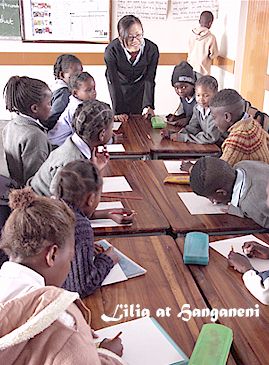 School in Swakopmund, Namibia.
School in Swakopmund, Namibia.
What type of technology do you use? At our school, we have computers, Internet and a television with a VCR. Our town is modern and has electricity and we use all kinds of electrical appliances, video games and such things.
What sports do you like? We like football (soccer), netball and athletics (track and field) most.
What types of food do you eat? We eat a lot of fish since we live near the ocean and a lot of meat since our country has lots of beef and goat farms. We also buy a lot of other food products that are mostly imported from South Africa, like pasta, rice and all kinds of fruits and vegetables. We also eat a lot of corn meal cooked in water – we call it pap. We eat it with whatever else is being served with the meal.
How many people are in your class? We have 42 students in our class and there are about 160 students in the four fifth grade classes.
What
is the average temperature where you live? It ranges from the fifties at
night to 80s and 90’s in the 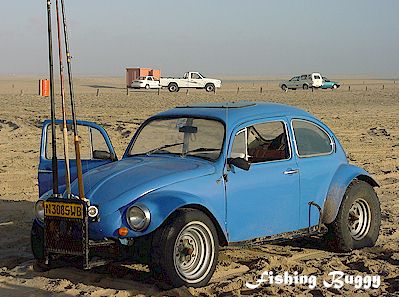 day,
though some days, especially the mornings, are quite a bit cooler. The temperature
depends mostly on the wind. We live between the sea and the desert. The winds
from the sea are cold, so they cool us down. But the winds from the desert
are hot (in the day) and they heat things up. Mostly the winds blow from the
sea, but for two months of the year, they blow from the desert.
day,
though some days, especially the mornings, are quite a bit cooler. The temperature
depends mostly on the wind. We live between the sea and the desert. The winds
from the sea are cold, so they cool us down. But the winds from the desert
are hot (in the day) and they heat things up. Mostly the winds blow from the
sea, but for two months of the year, they blow from the desert.
What types of crops do you grow in your country? We live in a desert, so we can’t grow any crops. All of our crops are imported. In the northern part of our country, where there is no desert, people grow corn and cassava and green vegetables (like collard greens) and a variety of fruits and palm nuts. (Last year, some of our school’s students visited a school in the north on a field trip.)
What religions are practiced in your area? Most people in Swakopmund are Christians, though there are a small number of Muslim families.
What
wild animals do you have in your area? We have many sea birds, including
terns, flamingos,  pelicans
and penguins, plus sea mammals like seals and dolphins. We also have jellyfish,
mussels, lobsters and many other kinds of fish. In the desert, there are gerbils,
foxes, beetles, spiders, oryx, springbok, ostriches and other birds, including
weavers, hawks, kites and vultures.
pelicans
and penguins, plus sea mammals like seals and dolphins. We also have jellyfish,
mussels, lobsters and many other kinds of fish. In the desert, there are gerbils,
foxes, beetles, spiders, oryx, springbok, ostriches and other birds, including
weavers, hawks, kites and vultures.
How
big is your school? We have over 1200 students at our school.
What
time does your school day begin and end? We begin the day at 7:30 and end
at 1:00.
What types of housing do you have? In our town, there are houses ranging from beautiful mansions built in a German architectural style to modern, medium sized homes to small rectangular cement houses provided by the government and the local mining company to very small houses made out of tin and wood.
Do you learn English in school? Yes, English is the official language of our country and we study it every day in school. It is also the language of instruction in some classes, while Afrikaans is in other classes.
-----------------------------------------------------------------------------------------------------------------------------------
THAT’S ALL FOR NOW
Well, that's it for this report. This week, we’ll be traveling to the Etosha Game Park, where, of course, we hope to see lots of wild animals. We’ll tell you about our trip in the next report. After that, we’ll travel to another desert in Namibia, the Kalahari, where we will visit a school called Mokaleng in a small village called Aminuis. Of course, we’ll tell you all about that, too. In the meantime, learn lots!
Paul Hurteau/Lilia
Cai
Africa School Project Coordinators
<><><><><><><><><><><><><><><><><><><><><><><><><><><><><><><><><><><><>

